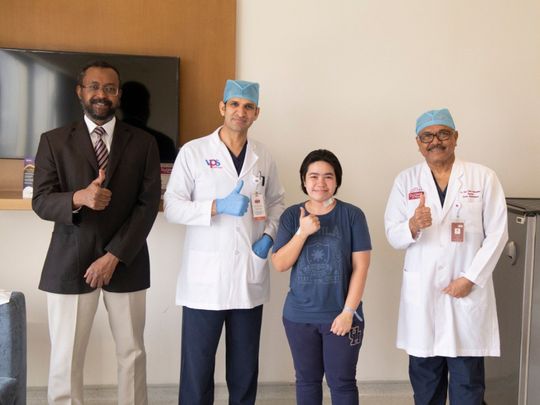
Dubai: In an instance of a rare lung disease, a 29-year-old Filipina expatriate recently underwent a complicated procedure to help her regain her proper respiratory functions.
The Whole Lung Lavage (WLL) was conducted at the Burjeel Hosptial, Abu Dhabi, in the first week of July. The process is complex as the lung is irrigated and flushed many times with 20-50 litres of normal saline.
What is Whole Lung Lavage?
The patient’s lung is flooded with normal irrigation saline through a double-lumen endotracheal (ET) tube under general anaesthesia and the milky fluid is sequentially drained until it becomes clear. This procedure can be carried out by experts in Interventional Pulmonology under anaesthesia, along with a cardio thoracic and vascular surgeon (CTVS) and an Extra Corporeal Membrane Oxygenation (ECMO) team. At Burjeel Hospital, Abu Dhabi, Dr Trilok Chand, pulmonologist, Dr Sivan Pillay, anesthesiologist, and Dr Tarig Mohamed El Hassan (CTVS) carried out the procedure.
Protein deposits in lung block the alveoli
The patient, Shanne Camille Francisco, a bakery worker from Al Ain, told Gulf News that she was diagnosed with Pulmonary Alveolar Proteinosis (PAP) a year ago.
“I used to feel breathless and tired and suffered from a dry cough. I underwent a lung biopsy and CAT scan. Initially doctors in other hospitals were unable to diagnose my condition and told me I had pneumonia. Only Burjeel Hospital confirmed my condition. I took a second opinion in the Philippines where they confirmed the PAP diagnosis, but no treatment was available there.”
Dr Chand added: “The disease is so rare that it occurs in 0.36-3.70 cases per one million population worldwide. PAP results in the abnormal accumulation of lipoporeteinaceous substance in the lungs. This clogs the alveoli in the lungs and results in breathing difficulty. Slowly, the oxygen saturation begins to drop. Normal oxygen saturation should be above 95-97. In the case of this patient, it fell to 93 when she was resting and even lower when she did any activity.”
He added that PAP was usually genetic, but can also be caused due to a lung infection or inhalation of chemicals or inorganic dusts.
21 litres of saline water used to flush out protein
The WLL procedure in the case of Francisco lasted three hours and her right lung was flushed with up to 21 litres of normal saline. “We have to irrigate the lung several times. The protein dissolves in the water and is flushed out. So we have to fill the lung and drain out the water many times. Initially, the water looks milky or even murky. After subsequent washes, it clears up as the protein is flushed out. The patient is able to breathe normally and resumes his or her job after the procedure. We will do a similar WLL procedure with her other lung by the first week of August,” explained Dr Chand.
Patient back on her feet
WLL procedures can last up to a year or two until the protein builds up again and has to be repeated. “In many cases after a few WLL procedures, the protein build-up slows down or in some cases comes down to a level where the patient can manage. In Europe and the US, an injection is available to prevent the protein build-up, but it’s too expensive. But in other parts of the world, the best way to deal with this is irrigation of the lungs with normal saline water, one lobe at a time,” said Dr Chand.
Francisco, who awaits a repeat of WLL in the left lung, is already feeling better. “My oxygen saturation came back to 97 per cent. I returned home within three days of the procedure and since then have also managed to work and do not feel tired anymore,” she said.








